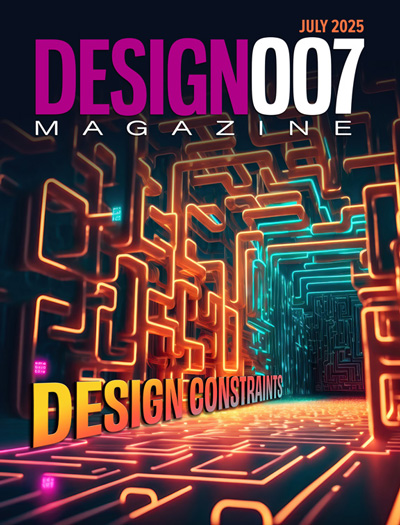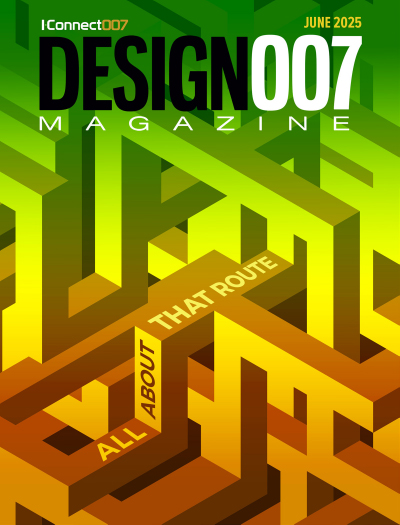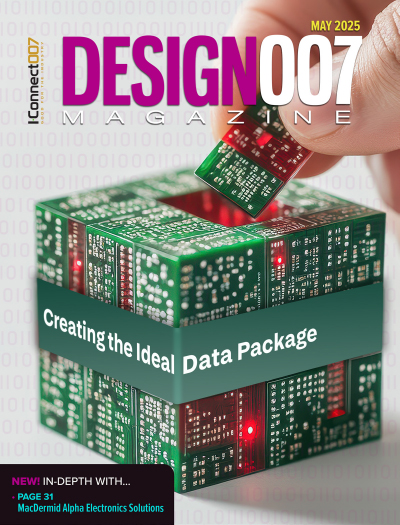-

- News
- Books
Featured Books
- design007 Magazine
Latest Issues
Current Issue
Showing Some Constraint
A strong design constraint strategy carefully balances a wide range of electrical and manufacturing trade-offs. This month, we explore the key requirements, common challenges, and best practices behind building an effective constraint strategy.

All About That Route
Most designers favor manual routing, but today's interactive autorouters may be changing designers' minds by allowing users more direct control. In this issue, our expert contributors discuss a variety of manual and autorouting strategies.

Creating the Ideal Data Package
Why is it so difficult to create the ideal data package? Many of these simple errors can be alleviated by paying attention to detail—and knowing what issues to look out for. So, this month, our experts weigh in on the best practices for creating the ideal design data package for your design.
- Articles
- Columns
- Links
- Media kit
||| MENU - design007 Magazine
The Gerber Guide, Chapter 3: The PCB Profile
November 30, 2015 | Karel Tavernier, UcamcoEstimated reading time: 1 minute
The Gerber Guide, Chapter 3: The PCB Profile (or Outline)
The profile defines the extent of the PCB. It separates the PCB from what is not the PCB and is an essential part of PCB fabrication data. Without the profile, the PCB simply cannot be fabricated. The profile must be properly and precisely defined.
The profile defines a simple region in the 2D plane. The proper way to do this is to specify a closed contour: The inside of the contour is the PCB, and the outside is not. It is that simple.
Note that such a simple region is solid, without holes. By definition then, a profile cannot have holes intentionally placed within it. These are superfluous and represent an unnecessary and complicated duplication given that drill holes are well defined in the drill/rout file. One can view cut-outs in a PCB as still part of the PCB, just as much as the drill holes are.
A contour is defined by the Gerber spec as follows:
“A contour is a sequence of connected draw or arc segments. A pair of segments is said to connect only if they are defined consecutively, with the second segment starting where the first one ends. Thus the order in which the segments of a contour are defined is significant. Non-consecutive segments that meet or intersect fortuitously are not considered to connect. A contour is closed: The end point of the last segment must connect to the start point of the first segment.”
The Gerber format regions are defined by contours using the G36/G37 commands. This is precise and unequivocal, and is the recommended way to specify the profile. The filled contour covers the PCB exactly.
If this is not possible, the profile can be specified by drawing the contour with a zero size or very small size aperture. If the aperture is not zero size, the profile is the center line of the stroked line; in other words, do not compensate for aperture size. You are transferring an image, not a production tool for a drill machine.
To read this entire article, which appeared in the October issue of The PCB Design Magazine, click here.
Testimonial
"Our marketing partnership with I-Connect007 is already delivering. Just a day after our press release went live, we received a direct inquiry about our updated products!"
Rachael Temple - AlltematedSuggested Items
New Podcast Episode Drop: Optimize the Interconnect and the Future of HDI
07/28/2025 | I-Connect007The Optimize the Interconnect podcast series continues with its second installment, featuring Chris Ryder, senior director of business development at MKS’ ESI. In this episode, Ryder shares compelling real-world examples that illustrate why Optimize the Interconnect is gaining traction across the industry.
New Podcast Series Launches: Optimize the Interconnect
07/16/2025 | I-Connect007I-Connect007 is excited to announce the debut of Optimize the Interconnect—a new podcast series featuring guest Chris Ryder, senior director of business development at MKS’ ESI. This insightful series explores how MKS’ ESI is rethinking microvia formation for today’s most advanced HDI PCB and substrate designs.
Trouble in Your Tank: Can You Drill the Perfect Hole?
07/07/2025 | Michael Carano -- Column: Trouble in Your TankIn the movie “Friday Night Lights,” the head football coach (played by Billy Bob Thornton) addresses his high school football team on a hot day in August in West Texas. He asks his players one question: “Can you be perfect?” That is an interesting question, in football and the printed circuit board fabrication world, where being perfect is somewhat elusive. When it comes to mechanical drilling and via formation, can you drill the perfect hole time after time?
Excellon Installs COBRA Hybrid Laser at Innovative Circuits
06/23/2025 | ExcellonExcellon is pleased to announce the successful installation of a second COBRA Hybrid Laser System at Innovative Circuits, located in Alpharetta, Georgia. The Excellon COBRA Hybrid Laser System uniquely combines both UV and CO₂ (IR) laser sources on a single platform—making it ideal for high-density prototype and production printed circuit boards (PCBs).
Gorilla Circuits Elevates PCB Precision with Schmoll’s Optiflex II Alignment System
06/23/2025 | Schmoll MaschinenGorilla Circuits, a leading PCB manufacturer based in Silicon Valley, has enhanced its production capabilities with the addition of Schmoll Maschinen’s Optiflex II Post-Etch Punch system—bringing a new level of precision to multilayer board fabrication.


